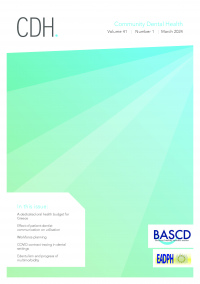September 2009
Consent of older children participating in BASCD coordinated dental epidemiology surveys in Wales.
Abstract
New guidance on consent for England and Wales, which has positive consent at its core, has implications for the UK-wide BASCD coordinated dental epidemiology programme. This paper describes a method used in Wales for obtaining consent from older children which is believed to comply with the new guidance. Objective The objective was to establish a more robust approach to gaining consent from 12 and 14 year olds taking part in the surveys, by building on existing “negative consent” practice and supplementing it with Gillick competent child consent. Design and setting Questionnaire data from the 2002-03 survey of 6,393 13-14 year-old children and the 2004-05 survey of 6,749 11-12 year olds were used in this analysis. Questions specifically designed to establish competency to consent were asked of participating children. These ascertained whether children were happy to proceed and if so, whether they understood the nature and the purpose of the survey and whether they were happy with the outcome. Results Ninety-nine percent of those taking part in both survey years were happy to proceed with the examination and questionnaire. Whilst the majority of children, agreeing to take part, indicated that they had understood what was proposed and were happy with the outcome, approximately 15% of these age groups gave answers after the event which indicated that they had not understood either the nature or purpose of the survey. Conclusion Use of “Gillick competent” consent in Wales did not affect participation rates adversely. The authors would suggest that indication of assent as used in Wales in these two surveys is appropriate and would only exclude 1% of children. The alternative, of examining only those children who answered questions on whether they understood the nature and purpose of what is proposed prior to assenting, would exclude 15% of children. Key words: Consent, dental surveys, epidemiology




